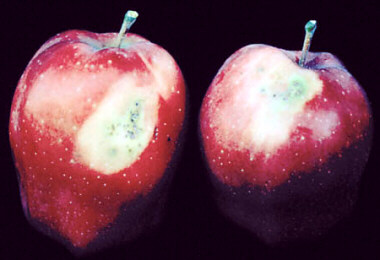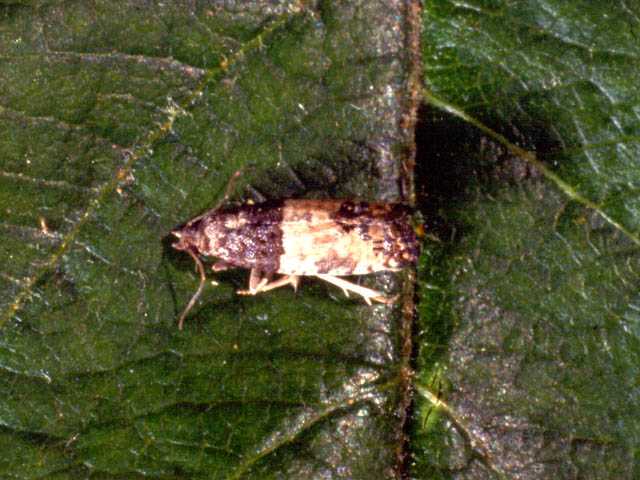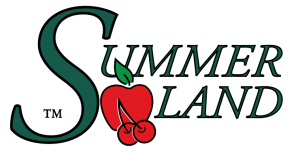Eyespotted Bud Moth
General Description
This pest is most common from Summerland north in the Okanagan Valley, and in the Fraser and Creston valleys. Its presence is becoming more noticeable in the South Okanagan and Similkameen valleys.
Hosts
Fruit trees, especially apple and cherry.
Damage
Buds - Webbed bud clusters including one or more dead leaves; infested blossoms do not open fully.
Fruit - Shallow irregular skin channels and tiny holes under dead leaf tied to the fruit (Fig. 1). Larvae will also feed on bagged apples. Damage can be confused that of obliquebanded and threelined leafrollers in late summer but is generally less extensive.
 |
| Figure 1. Apples damaged by eyespotted bud moth larval feeding. (AA-FC) |
Identification
Larva - Pale to dark chocolate brown body, about 10 mm when mature, with shiny black head (Fig. 2); wriggles backwards and drops on a silk thread when disturbed.
| Figure 2. Eyespotted bud moth larva. |
Adult - Grey moths about 9 mm long with a wide white band across each dark-coloured forewing (Fig. 3).
 |
| Figure 3. Adult eyespotted bud moth (BCMA) |
Life History
Young larvae overwinter in silken cocoons in the crotches of twigs and branches. They emerge in the spring near the green tip stage of apple and construct nests of leaves and blossoms, feeding mainly on the leaves. Larvae pupate in the nests and moths emerge from mid-June to late July. After mating, females lay eggs singly on leaves. Summer larvae tie dead leaves to fruit and feed on the fruit surface. In September larvae seek overwintering sites on the trees. There is one generation per year.
Monitoring
In spring look for feeding damage to leaves and bud clusters. Tight cluster to blossom is a good time to find any larvae in apple flower clusters. In late July and August examine fruit for surface feeding, usually in areas of red fruit where larvae attached a leaf or where two adjacent fruit were touching. A pheromone-baited trapping system is commercially available to monitor adults, however no relationship exits between moth captures and subsequent larval abundance.
Management
Chemical Control
It is important to control the spring generation of bud moth larvae in order to reduce the need to control the summer generation that causes the economic damage. Refer to the descriptions of leafrollers for additional management practices to minimize bud moth damage.
Apply a biological insecticide (Dipel 2X DF, Foray 48 BA, Bioprotec CAF or Bioprotec Plus) during bloom (and 10 days later if needed) will also provide control. Confirm and Intrepid applied for control of obliquebanded and threelined leafrollers in the spring or summer will aid in suppression of any bud moth and codling moth larvae present. Success, Entrust, Delegate, Altacor, and Exirel can also be used for control of bud moth larvae at petal-fall and in the summer. Success and Entrust can harm earwigs and parasitic wasps exposed to direct sprays; however there is no threat once the residues dry. Lack of insecticide applications in the spring or for second generation codling moth may require one or more sprays in July and August. This is especially true for stone fruits.
